Packing Tips and Advice
Figuring out
how to pack and ship an item can be confusing and stressful. Whether you are
wrapping up a care package for your sister or shipping ceramic bowls from your
pottery business, taking the proper steps to safely ship your package is
important. If you want to learn about proper packaging, read on for some great
tips and advice.
 |
| image:flickr.com/photos/halfbisqued/2353845688 |
Layer Up
For the safest
package, think in layers. Each type of packing material protects items in a
specific way, so capitalize on their strengths by using multiple types together.
Wrap your object in small bubble wrap, then in larger bubble wrap. Pad out your
box with large air pockets, and fill in smaller gaps with packing peanuts. Use
foam spacers to separate multiple items packed together in the same box, so
they can’t hit each other.
Surface Level
If you are
shipping something with a delicate surface, such as a painting, be cautious how
you pack it. Newspapers are usually a bad choice, as the ink can smudge and
leave marks on a canvas. Instead, wrap the face of the painting with clean
brown paper, or glassine, the material that professional
galleries use.
Order Matters
When packing
multiple objects in the same box, place the heaviest object at the bottom, and the
most fragile items on top.
Keep It Snug
Snugness is
key. If your item can slide around the box, it can break, even if the object
itself is well wrapped. In order to best protect your shipment, make sure there
is no wiggle room in the box. Pick an appropriate sized box for your object,
and fill any gaps with pouches of inflated air, wadded up bubble wrap, or
packing peanuts. You can even use smaller empty boxes as space fillers.
Double Down
 |
|
image:commons.wikimedia.org/wiki/
|
For truly
fragile items, such as glass or porcelain, double-box it. Bubble-wrap your item
and float it within a box of packing peanuts. The object should not be
touching the bottom, walls or top of the box, it should only be touching
packing peanuts. Float the box within a slightly larger box full of packing
peanuts. Any forces applied to the outside of the package should be evenly
distributed, keeping your breakable item nice and safe during transit.
The Shake Test
If you give
your final wrapped package a gentle shake, it should be silent. Nothing should
be sliding around. No objects should be able to hit each other.
Include a Packing List
Include an
item list inside your package, so the recipient knows exactly what they should
expect to find in the box. This simple tool can help keep communication clear
and eliminate needless phone calls or email exchanges with recipients who
aren’t sure if something is missing. If you are sending multiple packages to
the same recipient, label the boxes and the packing lists out of the total
number of packages being shipped, so they can be sure that they received all of
them. Include the shipping and return information on the packing list as well,
so that the shipping company can still deliver the items if something happens
to your external shipping labels.
Keep It Clean
Most lost
packages are caused by shipping label confusions. Use a fresh box, or if you
are reusing a box, make sure you remove all old labels, so your mail handler
doesn’t try to send your package to the wrong address. Print out your label on
the computer, so it is easy and clear to read, and double check the
address—especially the zip code.
Tape is Strength
Your box may
be packed, but you aren’t quite done. Proper taping is one the most important
parts of shipping a package. Packing tape is very strong, and is specifically
designed to work in conjunction with cardboard boxes. Don’t use masking tape,
scotch tape, or painter’s tape, all of which is too weak to withstand a
cross-country journey.
When you are
sealing up your box, don’t throw a single piece across the lid. Tape the lid in
an H shape, sealing the edges of the lid and the top. Tape the bottom in the
same way, so your box will be strong enough to support the weight of your
package.
Pack It Up!
Next time
you’re shipping an item, keep all these tips in mind to ensure your package
arrives safe and free of damage!
Author Bio:
Marian Sparks is a
freelance writer and a crafting enthusiast from Los Angeles, California. With
over 10 years of experience selling her handmade goods online and at shows, she
enjoys coming up with new ideas and finding inspiration at the Paper Mart blog.
During her free time, she also enjoys knitting and painting.






















0 komentar:
Post a Comment